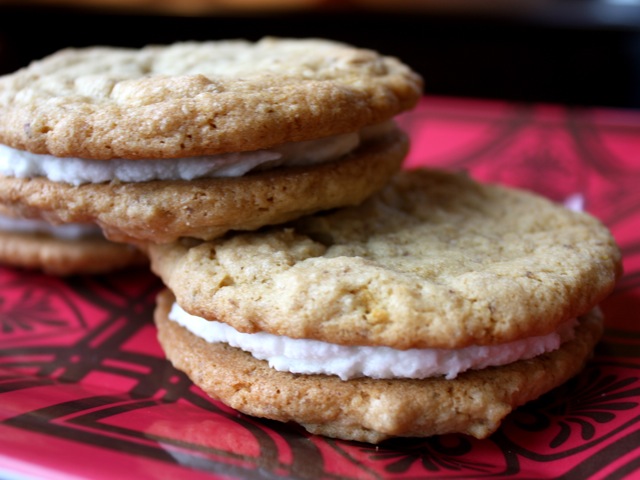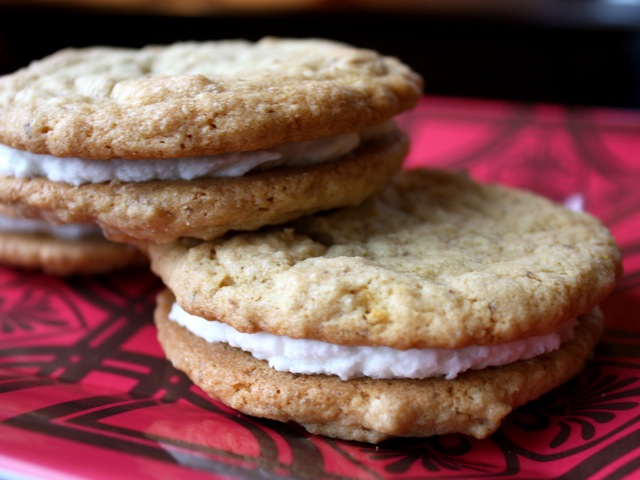
feature-image, l
(article, Zanne Miller)
[%pageBreakSettings nobreak=true] I have a daughter with a severe peanut allergy. We have many friends with gluten or dairy allergies or intolerances. And then there are our vegan friends, who don’t touch anything edible made from animal products. We’re not alone. An estimated 12 million people in the U.S. are allergic to various foods, and approximately 1.3 percent of the population has chosen to go vegan. [[block(sidebar). h1.Featured recipes]] Ditching nuts, wheat, dairy, and eggs isn’t too daunting when you’re making main dishes; there are plenty of savory options for people trying to eat around traditional American dietary expectations. But dessert can be a disaster. Nuts are often a main ingredient; even if they’re not, the nut-allergic are advised to scrutinize labels for traces of allergens, even in something as seemingly innocent as flour. And wheat, dairy, and eggs? It can be hard to imagine cakes or pies without wheat, puddings or ice cream without dairy and eggs. When you’re the one with the allergy or the dietary preference, you get used to being served the consolation dessert, the afterthought fruit or the ice-crusted sorbet. When you’re the one trying to make something appealing that fits your needs, you get used to kitchen frustrations and disappointments. (In my kitchen, many a gluten-free pie crust has ended up as a cobbler, and I had to chisel some gluten-free mix off the waffle iron a few weeks ago.) But in the past decade or so, options have changed. Bloggers began charting the course of their efforts to eat well on a restricted diet. Bakeries devoted to vegan desserts or gluten-free delights opened up around the country. And a slew of [content/299879 books] (not to mention magazines) documenting techniques and recipes for eating an alternative menu have been published. The next wave? Cookbooks on how to concoct toothsome desserts without causing grievous bodily harm. There's Annalise Roberts' Gluten-Free Baking Classics, practically a classic in the gluten-free field. There's Cybele Pascal's [%amazonProductLink "The Allergen-Free Baker's Handbook" asin=1587613484]. And there are books from all those bakeries, such as [%amazonProductLink "Flying Apron's Gluten-Free and Vegan Baking Book" asin=1570616299]. Here's a look at two recent alt-baking books. h3. The pan-allergy book With its simple title, full-page photographs, and easy-to-look-at design, Allergy-Free Desserts is a welcome addition to the alt-cookbook shelf and, for those who have not ventured too far down the gluten-free baking path, an excellent primer. Author Elizabeth Gordon, a baker who has egg and wheat allergies herself, has painstakingly recreated recipes for cookies, cakes, pies, and what she calls “extraordinary extras,” such as fudgsicles. My daughters and I pored over the yummy-looking treats, flagging our choices. Gordon’s lexicon of gluten- and- allergy-free baking was especially helpful for understanding the purpose and provenance of so many unfamiliar ingredients. It’s also full of handy tips, such as a reminder that garbanzo-bean flour tastes terrible before it’s baked. (Indeed — I once almost tossed the batter for an entire red velvet cake in the compost, thinking an ingredient had gone bad.) We fared better with Gordon’s cookies, which use a commercial product (Bob’s Red Mill Gluten-Free All-Purpose Baking Flour), than with her cakes, which call for using her own DIY blend dubbed Betsy’s Baking Mix. The baking mix combines the aforementioned garbanzo-bean flour with tapioca flour and potato starch, none of which are necessarily available in your local bulk-foods department when you need them. I decided to trust the manager at the natural-foods store when he told me that potato flour was the same thing as potato starch. Alas — as my cake batter turned out to have the consistency of Play-Doh — I learned that it’s not. (Lesson learned: Plan ahead, in case you have to specially order an ingredient.) The carrot cake, once I had the right supplies in hand, turned out much better — even if it did still have a bit of a gluten-free feeling. That wasn’t true of the cookies, which our tasters declared delicious. “You can’t even tell they’re gluten-free,” one friend marveled. We tried melt-in-your-mouth Chocolate Crinkles, Lemon Sugar Cookies (with lemon “buttercream” icing layered generously between two light, crunchy, not-too-lemony cookies), and Pretend Peanut-Butter Cookies (made instead with sunflower-nut butter), savoring their perfect chewy-crumbly texture. Gordon’s instructions were spot-on. When a recipe said the cookies would be done in 12 minutes, they were, and when it said “Makes 20 cookies,” it did indeed yield exactly 20 cookies. (I mean, that almost never happens, right? Especially when your “helpers” are licking everything in sight.) My vegan friends were happy to share in the bounty, too, and couldn’t believe that the desserts were made without butter or eggs. We also tried the Cool Mint Patties, which were quick and (we thought) even better than commercial mint patties. They kept well in the refrigerator for more than a week. If, like I do, you have little ones who like to indulge, I’d suggest making them a bit smaller than the recipe calls for — unless you want to hear “Do we have to cut them in half?” every day for a week. They’re that good. Some of the recipes, such as vanilla buttercream frosting, are complex, requiring specialty ingredients like Lyle’s Golden Syrup and multiple preparation steps. You can actually make a simple (not particularly gourmet, but functional) buttercream icing just by using Earth Balance in place of butter. But you may wish to try Gordon’s version at least once, deciding for yourself whether the extra steps are worth the effort. [%image feature-image float=right width=400 caption="Lemon Sugar Cookies turned into sandwiches with Vegan Fluffy Buttercream Frosting."] h3. The bakery book Divvies is a gourmet bakery in New York that makes and ships baked goods and treats without eggs, nuts, or dairy. Like Gordon, baker Lori Sandler has a personal reason for embracing allergen-free baking as a calling — her son, Benjamin, has life-threatening allergies to the aforementioned eggs, nuts, and dairy. Sandler’s business grew out of a desire to make treats that he could enjoy and share. The Divvies Bakery Cookbook shares that story, along with suggestions for entertaining people with allergies and even tips for party planning and including kids in the food preparation. Son Ben is very much a part of the book (it includes a “note from Ben” with his personal top-ten list). The book definitely has kids in mind. Speaking as a mom who’s been there, I appreciated Sandler's straightforward, light-handed info on dealing with food allergies. (For instance, she reminds you to check food labels every time, as manufacturing processes change and a once-safe food could no longer be safe.) This makes her book an excellent gift for parents who've just discovered that their child has an allergy, or for parents who just want to be sure their child’s birthday party is inclusive. (As Sandler puts it, “Inclusivity is key.”) Sandler's recipes range from cakes, pies, and candies to trail mix and granola bars, drinks, and other “fun” sweets and craft projects (popcorn snowmen or jelly-bean mosaics, anyone?). Confusingly, the recipes don’t have a clear organizing principle — there’s no “cakes” section or “candy” section, for example. While some recipes, like the Chocolate Bags, might seem daunting to make, even those were easy enough that a child could participate actively in the process. My family liked Sandler’s carrot cake and her chocolate-dipped pretzel sticks (easy, fast, and fun). We also enjoyed those fancy chocolate bags, which use flat-bottomed coffee-bean bags as chocolate molds. (I have to admit, we tried this as an enjoyably messy experiment, and never got to the part of the recipe where you fill the chocolate bags with sorbet or berries. We also fudged a bit and used recycled bags, so ours tasted a bit like coffee.) Divvies_ is also a good alt-baking primer, giving several pages on food substitutes and appropriate kitchen equipment. More experienced bakers can skim past such seemingly obvious suggestions as “Don an apron” or “Have dish towels and oven mitts on hand.” Unlike Gordon, Sandler doesn’t include much in the way of gluten-free recipes. You could try substituting Bob’s Red Mill gluten-free baking mix, or a homemade gluten-free baking mix similar to Gordon’s, but doing so might throw off other crucial baking factors, such as how the flours interact with the liquid ingredients. (Tip: If using gluten-free baking mix, be sure to add xanthan gum. The Bob’s Red Mill version lists appropriate measurements, depending on whether you are making, for example, a cake or cookies). Both books are good primers for someone just learning to navigate allergy-free baking. And I know we’ll be reaching for one or the other for the girls’ birthday party each winter. p(bio). Zanne Miller is a writer living in Eugene, Oregon. She's also a mom to two great little girls, one of whom has a life-threatening peanut allergy.

feature-image, l

reference-image, l